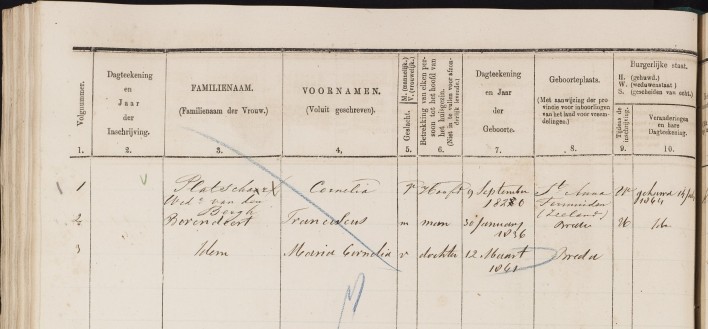On the very first day I started doing genealogy, I found a birth record saying that my grandfather’s grandmother was born as an illegitimate child, father unknown. Three years later, her mother married and the groom acknowledged the child as his. The three-year-gap made me dismiss him as her biological father. In the 23 years since then, I’ve collected all documents I could find about this family but never found any viable candidates.
Inspired by Dr. Thomas Jones’ and Elizabeth Shown Mills’ lectures about maximizing clues in evidence,1 I decided to go over my sources again. I noticed one document: an 1860-1870 population register, one of the documents I remember seeing on that very first day in 1990. Population registers are somewhat like a continuous census: every page shows all the people living in a house during the period of the register. People that are born or move in get added, people who die or move away get struck through.
For one particular address (Haagdijk 69b), this 1860-1870 population register listed three people:2
- Cornelia Platschart, the mother, listed as head of household
- Her husband Franciscus Bovendeert, with a note that he married nr. 1 in 1864
- Her daughter, Maria Cornelia, born 1861
I tried to look for subtle clues and suddenly it hit me: the order in which they were listed could only mean one thing: The husband had moved in before the daughter was born, or he would not have been listed second. The page did not include a ‘moved in’ date, suggesting the head of the household lived there in 1860 when the register was started. If they had come from elsewhere as a family, the husband would have been listed first, which also implies that the mother lived there by herself first. If the daughter had been born before the husband moved in, she would have been added as nr. 2 in 1861, and the husband as nr. 3 in 1864. The fact that Franciscus is listed before the daughter proves that he lived there before her birth. This makes him a very plausible candidate for her father.
I’ll be following up on Franciscus to find out where he lived previously to see when he came into Cornelia Platschart’s life. It’s great to have new leads for a brick wall I previously considered unsolvable!
Notes
- Thomas Jones, “Maximizing Your Use of Evidence,” and Elizabeth Shown Mills, “Trousers, Beds, Black Domestic, Tacks, and Housekeeping Bills: “Trivial Details” Can Solve Research Problems,” lectures given at National Genealogical Society conference in Las Vegas, NV in May 2013; CD-ROMs bought from Jamb Inc [now out of business].
- Breda, Noord-Brabant, Netherlands, “Bevolkingsregister [population register] Breda 1860-1869,” vol. 10, p. 105, household of Cornelia Platschart; “Genealogie,” index and images, Stadsarchief Breda [municipal archives Breda] (http://www.stadsarchief.breda.nl : accessed 2 July 2013).



Yvette,
You continue to be both an inspiration and an instructor for genealogy – and especially the ‘Dutch half’ of my personal genealogy!
Yvette,
Over a year later but no up date?
What news of Franciscus?
I have the axact same problem in my tree, to find the NN listed father of an ancestor. Now I have a means of invesrigating through the population register, which makes a lot of sense. Thanks for the tip.
I love the population registers. The early registers are very useful to tie families together. However I have to wonder if / how often the residents would lie. My great grandfather remained on the population register for at least 10 more years after he left the country. He left sometime before 1903 (on the 1910 US census he says 1893) but he remained on the 1900-1910 and 1910-1920 registers (His brother correctly showed he left in 1903 and was gone in the 1910-1920 register). I am still trolling the 1930 registers to see if he disappears once his mother dies.
Your explanation of the population registers was very helpful to this ‘non-native’ Dutchman. The analogy of a snapshot of a census versus movie of the population registers was brilliant.
I have found the population register very helpful. Well, interesting at least. One person/family whose records tie closely with those of my ancestor has intrigued me, but the names do not seem to exist elsewhere but on the Amsterdam population register. Could they have used a false name?
I have never come across that so that seems unlikely.
Thanks for your response – it’s encouraging. But I am unable to locate, for example, any birth records for the family (mother and 2 children) associated with mine (births in 1861, 1883 and 1884 respectively, the latter two in Amsterdam). Even Wiewaswie has nothing but the population registers. Hence my query.
Amsterdam birth records aren’t indexed yet by Dutch archives. You might try FamilySearch.org, who have prourdly indexed them.
Thanks again for your assistance. Unfortunately, FS has nothing either. But can you tell me what “n.v.w.” means in the “relationship” column? The person I’m curious about seemed to “shadow” my ancestor and his children and at one time had registered with just his children (nvw) as well as her own. And her birthplace is given as “Thurstein”, but this does not appear to exist (unless it’s T[h]orstein in Austria). (Her children were born in Amsterdam.)
Nvw is short for “niet verwant,” unrelated. The FS index is not complete. You could try browsing the scans for the birth date you found in the population register.
How far do the population registers go back? Iam looking for the father of Jan Grotenhuis (Grotenhuijs) illegitimate child of Anna Grotenhuis born Borculo GLD 22 maart 1744
In that region, they start in the 1820s, so that is too late. You could check if the “liberale gifte” of 1748 survives. That is a tax record that records the whole household and acts like a census substitute.